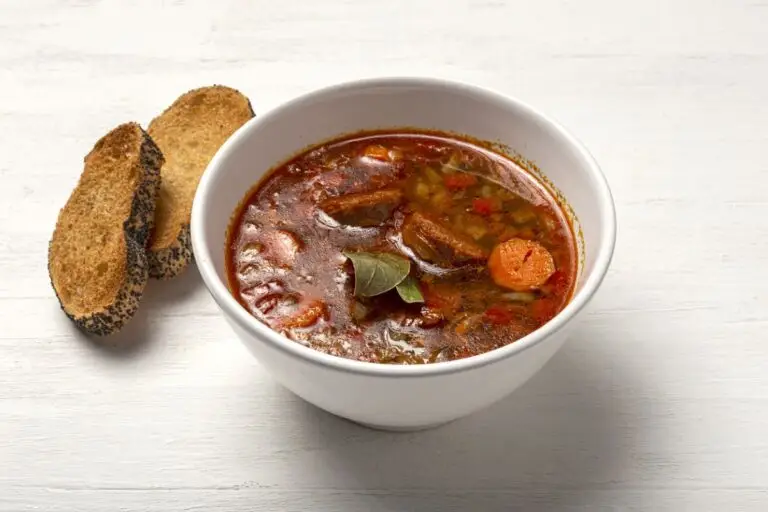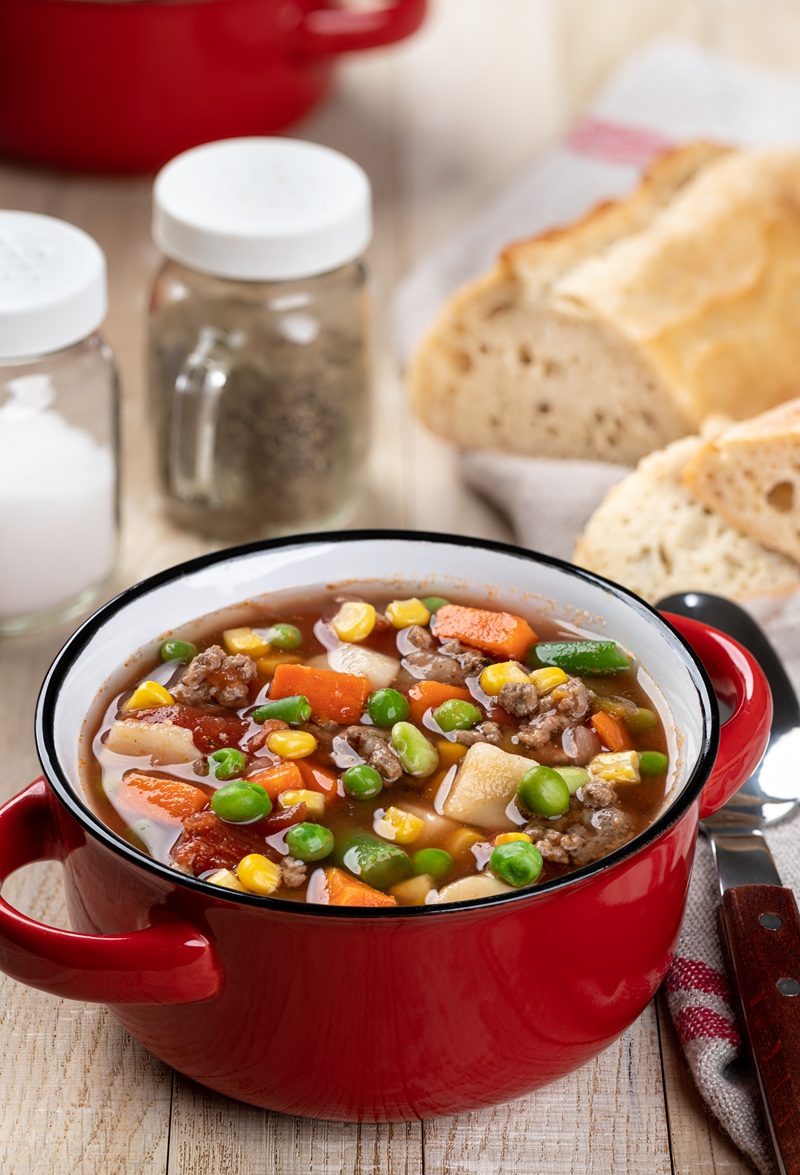This old-fashioned beef vegetable soup delivers fork-tender beef and perfectly cooked vegetables in under 3.5 hours using a simple stovetop method that requires just one pot. The extended simmering time transforms affordable stew meat into melt-in-your-mouth pieces while building deep, layered flavors that canned soup can never match. This beef vegetable soup is a fall favorite in our house.
My grandmother's kitchen always smelled like simmering beef broth on Saturday afternoons. She'd stand at her old gas stove, wooden spoon in hand, adding vegetables to her stockpot in careful stages. The steam rose, fogging the windows, while the soup bubbled quietly for hours. That patient rhythm taught me that the best food doesn't rush.
Historical Roots: From Medieval Kitchens to American Tables
Medieval French cooks developed early versions of this soup when royal chef Taillevent published recipes for ragout in the 14th century. Pots hung constantly over fireplace embers, becoming the ancestor of pot-au-feu as cooks added whatever root vegetables and meats they had on hand. The distinction between soup and stew emerged much later, mainly as a cultural difference rather than a culinary one.
By the 1820s, Americans made beef vegetable soup using fresh meat when available, though cured or smoked meat saved from fall butchering was more common in early spring. Cooks created beef broth from meat scraps and bones, then added potatoes, rutabagas, tomatoes, and whatever vegetables their gardens provided. They crushed dried herbs using mortar and pestle, then swung iron kettles over open flames using fireplace cranes.
Why This Old Fashioned Method Works
Ingredient Deep Dive
1.
Choosing Your Beef Cut
Beef chuck roast delivers the richest flavor and most tender results after the three-hour simmer. Pre-cut stew meat saves prep time but check the pieces for consistency. Avoid lean cuts like sirloin, which dry out during extended cooking. For budget-friendly alternatives, beef shanks add incredible depth though they require slightly longer cooking.
2.
Tomato Varieties That Build Flavor
This recipe combines three tomato products to create complexity: stewed tomatoes add texture and sweetness, diced tomatoes provide acidity that brightens the broth, and crushed tomatoes create body without overwhelming chunkiness. Italian-style canned tomatoes with herbs work beautifully, though plain varieties let you control the seasoning yourself.
3.
Fresh vs. Frozen Vegetables
Fresh green beans and frozen peas each bring advantages to the pot. Fresh beans hold their shape better during the long simmer, while frozen peas burst with sweetness since they're frozen at peak ripeness. Both carrots and potatoes must be peeled and diced into half-inch pieces for even cooking.

Heirloom Beef Vegetable Soup Recipe
This hearty beef vegetable soup is the kind of recipe grandmothers didn’t need to write down – just tender chunks of beef, a rich tomato-beef broth, and whatever vegetables were on hand. It’s forgiving, freezer-friendly, and tastes better the next day. The slow simmer is what makes it work, turning humble stew meat into something that tastes like you spent all day in the kitchen (even though most of that time is hands-off).
- Total Time: 3½ hours
- Yield: 10-12 servings 1x
Ingredients
- 1 pound beef stew meat
- 1 tablespoon minced garlic
- 2 tablespoons olive oil
- 32 ounces beef broth
- 26 ounces beef stock
- 1 - 14.5 ounce can stewed tomatoes
- 1 - 14.5 ounce can diced tomatoes
- 1 - 28 ounce can crushed tomatoes
- 1 teaspoon seasoned salt
- 2 bay leaves
- 1 tablespoon herbes de provence
- 1 teaspoon oregano
- 1 teaspoon parsley
- 1 teaspoon basil
- ground pepper
- 1 chopped onion
- 4 peeled & diced carrots
- 2 peeled & diced potatoes
- 1 diced zucchini
- 4 ribs celery
- 16 ounce bag fresh or frozen green beans
- 14.5 ounce bag frozen peas
Instructions
- Brown the Beef
Heat 2 tablespoons olive oil in a large stockpot over high heat. Add the stew meat (tenderized with salt and pounded with a mallet if desired) and 1 tablespoon minced garlic. Brown the meat on all sides, about 5-7 minutes total. - Build the Base
Reduce heat to medium. Add the beef broth, 2 cups water, and all three cans of tomatoes (stewed, diced, and crushed). Stir to combine. - Season the Broth
Stir in the seasoned salt, bay leaves, herbes de Provence, oregano, parsley, basil, and several grinds of black pepper. Cover and bring to a gentle simmer. - Prep the Fresh Vegetables
While the broth simmers, dice 1 large onion, 4 peeled carrots, 2 peeled potatoes, 1 zucchini, and 4 celery ribs into ½-inch pieces. - Add Fresh Vegetables
Add all the fresh vegetables to the stockpot. Stir well, cover, and simmer for 1 hour, stirring occasionally. - Finish with Frozen Vegetables
Add the frozen green beans and frozen peas. Cover and simmer for an additional 2 hours, or until the beef is fork-tender and all vegetables are cooked through. The longer simmer time allows the flavors to meld beautifully. - Serve
Remove and discard the bay leaves. Ladle into bowls and serve hot with crusty bread or fresh dinner rolls.
Notes
Feel free to use modern Italian-style canned tomatoes or the basil variety.
- Prep Time: 20 minutes
- Cook Time: 3 hours, 10 minutes
- Category: Soups & Stews
- Method: Stovetop
- Cuisine: English
Essential Techniques
Common Substitutions
Swap zucchini for yellow squash, add a handful of pearl barley for heartiness, or stir in fresh spinach during the last 10 minutes. Herbes de Provence can be replaced with equal parts dried thyme, rosemary, and oregano. If you prefer a thicker soup, mash a few potato pieces against the pot side or stir in a tablespoon of tomato paste.
Recipe Variations And Serving Ideas
Serving Ideas
Ladle steaming bowls and serve alongside crusty sourdough bread, warm dinner rolls, or homemade cornbread for soaking up every drop of broth. A simple green salad with vinaigrette provides fresh contrast to the rich, hearty soup. For gatherings, set out saltine crackers, oyster crackers, and freshly grated Parmesan so guests can customize their bowls.
Frequently Asked Questions
Ground beef works in a pinch but won't deliver the same tender, chunky texture or rich flavor. Brown it completely and drain excess fat before adding liquids.
Cut against the grain into uniform pieces and allow the full three-hour simmer time for connective tissue to break down. Cutting pieces too large extends cooking time.
Brown the beef first on the stovetop, then transfer everything to a slow cooker and cook on low for 6-8 hours or high for 3-4 hours.
The soup thickens as it cools and the starches from potatoes and tomatoes incorporate. If still thin, simmer uncovered for 20 minutes to reduce liquid.
Cook pasta or rice separately and add to individual bowls rather than the pot, preventing them from absorbing too much broth and becoming mushy.
Cool completely, then ladle into freezer-safe containers, leaving one inch of headspace for expansion. Label with the date and freeze for up to 3 months.
Peeling removes any bitterness and creates a cleaner appearance, though leaving skins on adds nutrients and rustic texture.
This soup excels as meal prep since flavors improve over 2-3 days. Make a double batch on Sunday for easy weeknight dinners.
Bay leaves, thyme, and herbes de Provence create classic depth, while fresh parsley stirred in at the end adds brightness.
The meat should fall apart easily when pressed with a fork and shred without resistance. If still chewy, continue simmering in 30-minute intervals.
This soup endures because it honors simple ingredients and patient technique rather than chasing shortcuts. The same method that worked in 1820s homestead kitchens still produces the tender beef and perfectly cooked vegetables that turn a pot of soup into something worth making again and again.
What memories does the smell of simmering soup bring back to your kitchen?



0 comments